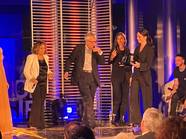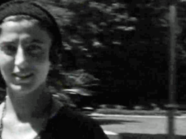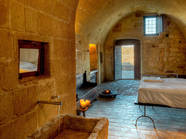Making the City Home
Joseph Sciorra, a folklorist and the director for academic and cultural programs at the Calandra Italian American Institute, remarked that he has presented his research in academic settings, church basements, and social clubs.
"This is the first time I've presented in a bar," he said, as he took his place behind the counter at the Owl's Head, a wine bar in Bay Ridge, Brooklyn.
Sciorra came to the Owl's Head on May 20 to talk about his new book, "Built with Faith: Italian American Imagination and Catholic Material Culture in New York City" (University of Tennessee Press). The book is the culmination of thirty-five years of studying the devotional art and architecture that Italian American Catholics have created in New York City. Sciorra focuses on examples of "vernacular expressive culture" – yard shrines, domestic and public altars, presepi (Nativity scenes), religious processions, and Christmas house displays – to explain how Italian Americans "transform their homes, their front yards, their streets, their neighborhoods, and make this crazy transnational city into a place that's home."
You might think that a wine bar would be an unlikely place for an academic to present his research. This writer did. Before arriving, I wondered whether an after-work drinking crowd would pay quiet attention to Sciorra's talk. But sipping their beverages and nibbling the bar's light fare, they listened closely as Sciorra spoke and projected images from his book on a wall.
If the choice of venue seemed unusual, the Bay Ridge location was fitting. Although it is often believed that Italian migration to the United States ended in the 1920s, a new wave began after quotas on Southern European immigration were lifted in 1964. Bay Ridge, Sciorra said, is "a major neighborhood in southern Brooklyn that was transformed by the new influx of immigrants." John Avelluto, the young, lushly bearded owner of the Owl's Head, is a son of southern Italian immigrants who settled in south Brooklyn.
Sciorra's ethnographic research, which he conducted in people's homes, and at religious and other community events, is the heart of his book. To interpret his findings, he draws on a wide range of literature, from anthropology, social history, gender theory and cultural studies, and Italian/Italian American studies. Sciorra deftly orchestrates his original research and his other sources to produce an account that not only challenges common conceptions of phenomena like yard shrines ("Mary on the half-shell") and Nativity scenes as kitschy or spiritually vapid. His book, by explaining what the examples of "vernacular expressive culture" mean to the people who create them, offers a new way of seeing them.
Sciorra said that his aim was to show "the vibrant and varied ways contemporary Italian Americans have used and continue to use material culture, architecture, ritual behavior, and public ceremonial display to shape New York City's religious and cultural landscapes."
He stressed that Italian American devotional art and architecture do not represent "a mindless carryover from the old world that people continue to perpetuate because they don't know what they're doing." They understand the art forms they work with and their historical roots, and the art's relationship to place, to making the city a home.
Sciorra rejects such dichotomies as "folk" or "popular" religion versus "official" religion. These categories, he argued, "demean what people do." "I am more interested in looking at it as lived religion, how people practice their religion, how they think about religion."
"People were constantly interpreting Catholicism as I was talking to them," he said. "They don't leave it to their clergy to explain everything to them." One Brooklyn man, who has built an altar in his living room, considers himself a traditional Catholic. "He goes out of his way to attend a Latin mass," said Sciorra. "But he diverges from Vatican on homosexuality, marriage, and divorce. He doesn't see those as contradictions for him. It is part of how he understands, interprets, and lives his religion."
He described the various forms of creative expression he discusses in the book as "sacramentals – those objects or behaviors that help to make the divine present in the everyday." The shrine and altar builders and presepio makers "manifest religious belief through material culture – the visual arts, sculpture, architecture."
Sciorra said that Italian Americans in New York City have created a unique style comprising "a profound respect for craft and skills executed well, a love of cement and stonework, a delight with the principles of accretion and the interplay of seeming contrasts." (The ruling aesthetic is definitely not minimalism.) "In presepi, in home altars, people put things together that seem to make no sense but when you talk to them, when you understand what's going on, there's a real interrelationship. They have interrelated meanings, whether there's a figure of Our Lady of Mt. Carmel next to photographs of children and grandchildren."
In the elaborate, often over-the-top Christmas home decorations that have made the Brooklyn neighborhood of Dyker Heights world-famous, Sciorra sees "an appreciation for festivalized intensification and exuberance." With the Christmas displays – the only practice Sciorra discusses that did not originate in Italy – "private property becomes public spectacle."
"The thing about folklore, anthropology, and ethnography," he said, "is that you talk to people and you listen. People are incredibly articulate and thoughtful about their lives, belief systems and about the art they create." It is easy to dismiss the Christmas decorations as "kitschy, nouveau riche, ostentatious display" but "there's a whole lot more going on," Sciorra said. He sees a connection between the extravagantly decked-out homes and the presepi, and to "the festive light displays that used to happen in religious processions."
After his talk, a woman asked Sciorra whether the vernacular culture he has documented might die out, as individuals age and Italian American communities change.
"When I first started this study in '80s I was asked the same thing," Sciorra replied.
He began his research in the '80s; by the next decade, there were 1,880,000 Italians in New York City. By 2001, that figure had declined to 590,000. "That's a significant decrease," he acknowledged, "but it's still a lot of people." Media accounts typically present stories of decline – "the last [Italian] butcher is leaving the neighborhood" – but Sciorra noted, "Italians still exist here and still continue to contribute in significant ways."


































Comments
1
1
1
1
1
1
1
1
1
1
1
Pages